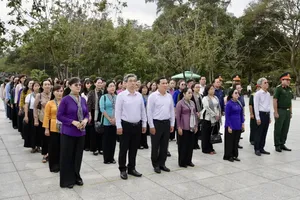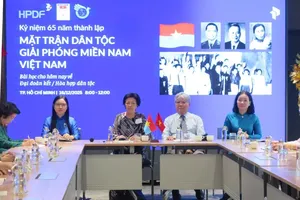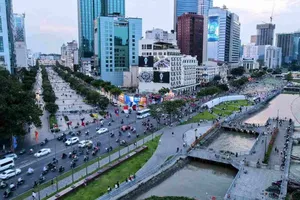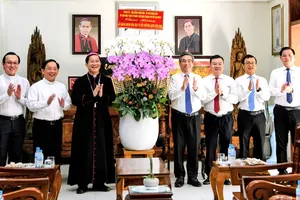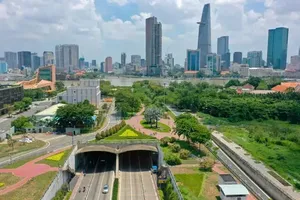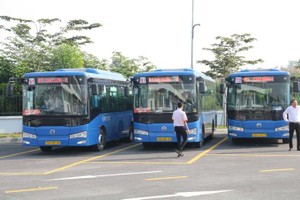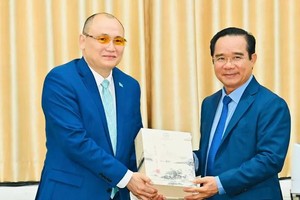
Aside from that, HCMC will soon build the Innovation District in the East of the city, making it a large innovative eco-system in the southern region, he revealed.
At the event, Mr. Nhan also raised his concerns over challenges in developing private enterprises.
In 1991, HCMC had one state own, one private and one foreign invested firm in every three enterprises. In 2006, there were 1 state own and 11 foreign firms in every 1,000 newly established companies. In 2018, the rate was 1 state own, 30 foreign and 969 private firms in every 1,000 newly established companies. The ratio change shows that the private sector has held the majority of scale and capital in the city for the latest years.
State own firms kept 57 percent capital of all businesses in 1991. The ratio fell to 4 percent in 2018 when private ones made up 85 percent.
For the last three years, HCMC has had 121,000 newly established companies with the total capital of VND1,467 quadrillion (US$64 billion); the private sector has accounted for one third in the total number of newly established companies and one third of capital.
That shows the great role of private firms in HCMC. They are contributing to 63 percent of Gross Regional Domestic Product and over 41 percent of city budget revenue. For the last three years, the number of operating businesses in HCMC (mostly private ones) accounts for over 50 percent of the total number of businesses nationwide.
Investment structure is reasonable in overall but there have been problems. For instance, in the real estate field, 43 percent of enterprises are investors, the number of real estate firms is only 6.1 percent. Manufacturing and processing companies make up only 6 percent of capital and 10 percent of business number. Communications technology and science and technology field play great role to Industry 4.0 but these two fields’ investment makes up only 8 percent of capital and 13 percent of business number. These are weaknesses and imbalances in the structure of investment and businesses of HCMC.
Currently, HCMC is implementing key solutions to assist private firms. For instance, it has invested VND315 billion ($13.55 million) in scientific researches, maintained technology exchange with 4,700 technologies being offered for sale to 800 suppliers and 100 organizations and consulting experts. In addition, the city is seeking partners for 200 projects. Annually, the city bestows awards in recognition of 100 outstanding enterprises and 100 outstanding entrepreneurs.
There are seven difficulties which HCMC have to face and need to find solutions quickly. Firstly administrative procedures and state management to businesses are complicated and outdated compared to many countries.
Secondly, the law is overlapped, asynchronous and contradictory with time consuming solving process. Thirdly, capital shortage is the basic reason for low labor productivity.
Businesses in HCMC account for 52 percent of the country’s number but they make up only 15 percent of total capital. Hence their capital demand is very large.
Labor productivity in Vietnam is far inferior to other nations. One of the important reasons is the investment level per worker in Vietnam is low. In 2013, Vietnam’s labor productivity was 20 time lower than Japan and 6.5 times lower than Malaysia.
The fourth problem is land and house shortage and inefficient business establishments. Tens of thousands of businesses have been established in the city without infrastructure planning and service development, hence it needs funds for infrastructure planning and service development in big cities.
Fifthly, Vietnam has no strong policies to encourage development and big volume establishment of information technology and science and technology companies to create a core force for the knowledge economy and service production.
Sixthly, businesses have not been in the habit of coordinating with and ordering educational facilities to train human resources for them. Finally, authorities at all levels have not considered businesses’ satisfaction as the most important index to estimate administrative reform.
HCMC believes that after the forum, the Government will renew policies and better and faster meet businesses’ demand. Localities including HCMC should repair their weaknesses together with businesses’ efforts to develop the country. HCMC will strive to maintain labor productivity which is 2.9 time the country’s average level, budget revenue per worker which is triple the country’s average level.
Mr. Nhan hoped that most of difficulties of private firms would be solved in the next forum, the country will develop faster and more sustainably and the number of satisfied businesses will increase.
